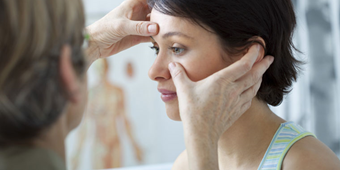Diabetes Can Have a Ripple Effect On Your Health

Answer a few questions and we'll provide you with a list of primary care providers that best fit your needs.
More than 34 million Americans have diabetes, and about 20 percent are not aware they have it, according to the American Diabetes Association (ADA). Uncontrolled diabetes can lead to heart disease, kidney failure, leg infections, gingivitis, and other serious health problems.
The ADA adds that people with diabetes have a higher risk of blindness than people without diabetes. And if you have uncontrolled diabetes, you may also experience minor eye disorders. With regular checkups with your doctor, you can keep minor problems minor.
There are three major types of diabetes:
- Type 1 diabetes. This type is usually diagnosed in childhood, although it can occur at any age. In this disease, your body makes little or no insulin. Daily injections of insulin are needed. The exact cause is unknown. Genetics, viruses, and autoimmune problems may play a role.
- Type 2 diabetes. This is far more common than type 1. It makes up most of diabetes cases. It usually occurs in adulthood, but young people are increasingly being diagnosed with this disease. The pancreas does not make enough insulin to keep blood glucose levels normal, often because your body does not respond well to insulin. Many people with type 2 diabetes do not know they have it, although it is a serious condition. Type 2 diabetes is becoming more common due to increasing obesity and lack of exercise.
- Gestational diabetes. This type involves high blood glucose that develops at any time during pregnancy in women who do not have diabetes. Women who have gestational diabetes are at high risk of type 2 diabetes and cardiovascular disease later in life.
Symptoms And Diagnosis
Diabetes results in too much glucose in the blood causing damage to body systems such as the eyes, heart, nerves, and circulatory system. Other symptoms include:
- Increased thirst
- Frequent urination
- Increased hunger
- Blurred vision
- Fatigue
- Dry skin
- Moodiness
- Wounds that won’t heal
- Numbness of the hands/feet
The following blood tests are used to diagnose diabetes:
- Hemoglobin A1c test. This gives an average blood glucose level of the last 2 to 3 months. You're diagnosed with diabetes if your A1c value is 6.5% or higher.
- Fasting blood glucose level. Diabetes is diagnosed when the glucose level is higher than 126 mg/dL on two occasions. Levels between 100 and 126 mg/dL are referred to as impaired fasting glucose, or prediabetes. These levels are considered to be risk factors for type 2 diabetes and its complications.
- Oral glucose tolerance test. Diabetes is diagnosed if the glucose level is higher than 200 mg/dL after 2 hours. (This test is used more for type 2 diabetes.)
- Random (non-fasting) blood glucose level. Diabetes is suspected if higher than 200 mg/dL and accompanied by the classic diabetes symptoms of increased thirst, urination, and fatigue. (This test must be confirmed with a fasting blood glucose test.)
Diabetes Treatment
Persons with diabetes need to have their hemoglobin A1c (HbA1c) level checked every 3 to 6 months. The HbA1c is a measure of average blood glucose during the previous 2 to 3 months. It helps determine how well treatment is working.
Long-term goals of treatment are to:
- Prolong life
- Reduce symptoms
- Prevent diabetes-related complications such as blindness, heart disease, kidney failure, and amputation of limbs
You, with the help of your health care provider, can accomplish these goals through:
- Blood pressure and cholesterol control
- Careful self-testing of blood glucose levels
- Education
- Exercise
- Foot care
- Meal planning and weight control
- Diabetes medication and/or insulin
If you have diabetes, regularly check your blood sugar levels at home. There are a number of devices available, and they use only a drop of blood. Self-monitoring tells you how well diet, medication, and exercise are working together to control your diabetes. It can help prevent complications.
The ADA recommends keeping blood sugar levels in the range of:
- 80 - 120 mg/dL before meals
- 100 - 140 mg/dL at bedtime
Your physician can provide you with information about how much fat, protein, and carbohydrates you need in your diet. A registered dietitian can help you plan your individual dietary needs.
If you have type 1 diabetes, eat at about the same times each day and try to be consistent with the types of food you choose. This helps prevent extreme swings in blood sugar. If you have type 2 diabetes, maintain a well-balanced, low-fat diet.
Feet, Eyesight, And Oral Health
With diabetes you are more likely to have foot problems. Diabetes can damage blood vessels and nerves and decrease your body's ability to fight infection. You may not notice a foot injury until an infection develops. Death of skin and other tissue can occur. You should check your feet every day and let your physician know if you are having problems with your feet at your next appointment.
Your physician may also emphasize that you schedule regular eye exams, because the most common eye disorder with diabetes is retinopathy, which can lead to poor vision and even blindness. Diabetes also puts you at higher risk for developing cataracts and certain types of glaucoma.
Diabetes can also lead to oral health issues, so it is important to also have routine dental appointments if you have diabetes.
Answer a few questions and we'll provide you with a list of primary care providers that best fit your needs.
Source: American Diabetes Association




